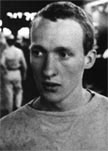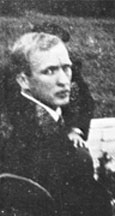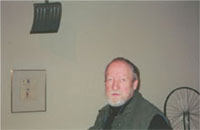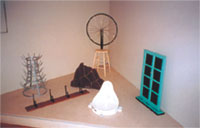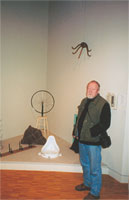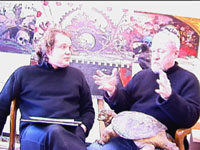"A very normal guy" Robert
Barnes on Marcel Duchamp and Étant Donnés
The American painter Robert Barnes, recently elected member of the American Academy of Design, is a very private person and doesn't care much for publicity. It was only after many phone calls and letters that he finally agreed to a lengthy interview in his studio in Bloomington, Indiana, on January 27, 2001. Besides a brief book review of Calvin Tomkin's biography of Marcel Duchamp (Duchamp: A Biography, New York: Henry Holt, 1996) published in Blackwell's Britain-based The Art Magazine in 1997, he had never before spoken about his close encounters with Duchamp and other Surrealists in New York during the 1950's. Though refusing to be called "Duchamp's last assistant" he admits that it was he whom Duchamp had asked to pick up the pig skin for Étant Donnés in Trenton, New Jersey*. The following interview, therefore, sheds some new light on the production of Duchamp's final major work as well as his edition of Ready-mades in1964, and reveals heretofore unknown facets about Duchamp, and those who knew him at the time.
Tout-Fait: There are a lot of questions that I want to ask you--about you and your art and the people you knew. Let's just start with Étant Donnés (Fig. 1, 2), Duchamp's final masterpiece that he supposedly worked on in secret between 1946 and 1966. You apparently knew about the piece before it was posthumously revealed at the Philadelphia Museum of Art in 1969? Robert Barnes: Lots of people knew about it. I don't know what this great mystery is. I am sure that Matta (1) knew about it. And if Matta knew about it, everyone in the world knew about it. Matta was a bigger blabbermouth than I was. But, you know, a lot of mystique about Duchamp and all of the legends and stories that have grown up around him were basically manufactured much later and Étant Donnés, well you know, I think it's his masterpiece. A lot of people are critical of it. I think they are critical of it because it embarrassed them. But it is the bride fleshed out and it is the appropriate final production that Duchamp created. The secrecy -- to tell you the truth -- I don't think is very important because everything about Marcel was secret and known, that's the way he was. Tout-Fait: And you were born in 1934? Robert Barnes: Yeah, but I don't admit it to many people. Tout-Fait: You came to New York when you were 19 I think you said? Robert Barnes: No, twenty-something. Tout-Fait: Oh, you had married when you were 19. So you were introduced to that circle of artists by... how did you get to know them?
Robert Barnes: Through Matta. Tout-Fait: And how did you come across him? Robert Barnes: I met Matta when I was a young man in Chicago. It is interesting with people. You know who you can know, and you know who you can like, and there are affinities that are expressed without ever having an explanation. The same was true with Marcel, except Marcel liked everybody. But Matta and I just had an affinity and he was good to me, he was careful with me. He helped me, and there's an interesting story to indicate this. He was staying in Chicago, in some hotel, and he invited me out to his place and I was delighted to go because, at that time, he was living with what I guess was said to be his wife, but I'm not sure she ever was: Mellite, a gorgeous French woman and I was totally in love with her. And I was delighted to go. I was more interested in her than in Matta at the time. When I was a young man, I was overly sensitive to things, and I found it difficult to eat when I was nervous. I was just sort of paralyzed. It was terrible on dates, because I could never eat when I was on a date. And I went to this dinner and Matta said to me--I was sitting there looking uncomfortable--and he said "You have a problem eating, don't you, when you're uncomfortable?" and I said, "Yeah" and he said, "So did I." Now I don't think he ever did. I don't think Matta was ever uncomfortable. He said, "Let's drink this wine." And he had discovered a catch at a low price of a wine, called "Grand Echeseaux," which he dearly loved; it was his favorite wine. He bought tons of it. And after a couple of glasses, I totally relaxed. What I am telling you is that Matta had a way of making you feel comfortable and that's probably why he had nine wives because he made them feel comfortable and then uncomfortable later. Tout-Fait: Now that was Matta. But I have to get back to Étant Donnés. You said you were not Marcel Duchamp's assistant but he told you to get certain things for this piece. Robert Barnes: I am uncomfortable with that story. Let me tell you that Matta did introduce me to Marcel the first time, that's how it happened. He took me up to Duchamp's apartment. It was in the 50's, near Bloomingdale's (2). Tout-Fait: He was already married to Teeny then. Robert Barnes: Yeah. But you want to go back to Étant Donnés. I would never admit this, but I went to New Jersey to get the pigskin. Tout-Fait: He asked you to? Robert Barnes: Yeah. And I didn't know how to drive a stick shift and I didn't have a driver's license but I took this truck and I don't know whose truck it was, probably some merchants, and picked up this pigskin. Tout-Fait: He had already ordered it and just wanted someone to pick it up for him. Robert Barnes: Yeah. The thing is, this is going to screw up all of your research because I think that this was his second pigskin. I think he had one before. I don't know whether it was to patch. You know when I was on the scene it was late Étant Donnés, he was already in the process pretty much. Tout-Fait: Officially he started working on it in 1946, and below the signature he writes 1966. Robert Barnes: That's way late. It was done sitting, gathering dust by then. It was in the ‘50's, ‘56. Tout-Fait: So how did he first introduce you to it?
Robert Barnes: Well I was at his apartment and he asked me if I'd pick up the pigskin and I did. But I knew about it before then, that's the thing, everyone sort of knew about this thing and most people hated it and thought it was a waste of time. I loved it; you know I thought it was his masterpiece. Although the Large Glass (Fig. 3) is probably the monument but this is the masterpiece because it tested people's ability to accept Marcel. Now we accept him. Tout-Fait: Well a lot of people still don't. Robert Barnes: Well too bad. Tout-Fait: When you saw the piece, the door wasn't there, the door came very late. Robert Barnes: No. When I saw it, it was all over the place, it was in pieces. And my suspicion was that he put the skin on earlier and it cracked. He had a terrible time keeping it soft. There was a beauty shop downstairs and awful smells came out of that place it was enough to give you asthma and die just going up to Marcel's studio. And I think he actually asked them about lanolin and skin softeners to use on his skin. No not on his skin, on the pig's skin. My feeling is that either the pigskin that I got--which I never actually saw, it stayed in the brine -- it might have been just to patch it. Do you know when they took it apart were there patched pieces?
Notes
Figs.
1-3
|
|||||||||||||||||||||||||||||||||||
